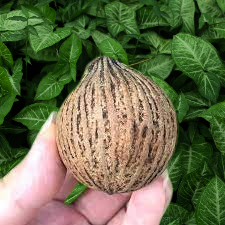Jungli Garlic
Jungli Garlic, known botanically as Allium tuberosum or locally as “Jangli Lehsan,” is a wild, aromatic herb deeply rooted in the culinary and medicinal traditions of Gilgit-Baltistan. Unlike cultivated garlic (Allium sativum), this hardy plant thrives in the rugged terrains of the Himalayan mountains, particularly in regions like Ghizer, Hunza, Skardu, Ishkoman, and Darkut. Its intense, earthy flavor and powerful medicinal properties make it a prized ingredient among the indigenous communities of northern Pakistan.

For centuries, the people of Gilgit-Baltistan have foraged jungli garlic from high-altitude meadows, forest edges, and riverbanks, using it not just as a food source but also as a natural remedy. Its strong, pungent aroma and sharp, slightly bitter taste set it apart from regular garlic, making it a favorite in traditional dishes and herbal treatments.
Botanical Features and Habitat
Jungli garlic is easily recognizable by its distinct physical characteristics:
1. Leaves
- Long, flat, and grass-like, similar to chives but broader and tougher.
- Bright green in color with a fibrous texture, growing in dense clumps.
2. Flowers
- Small, white, star-shaped flowers that bloom in clusters during late summer.
- Attract bees and other pollinators, contributing to local biodiversity.
3. Bulbs
- Smaller and more fibrous than commercial garlic bulbs.
- Extremely pungent when crushed, releasing a strong garlicky aroma.
4. Growth Habitat
- Thrives in the wild, uncultivated landscapes of Gilgit-Baltistan, particularly in:
- Ghizer – Found in high-altitude pastures.
- Hunza – Grows near riverbanks and terraced fields.
- Skardu – Common in rocky slopes and alpine meadows.
- Ishkoman & Darkut – Flourishes in moist, forested areas.
- Prefers cool climates and well-drained soil, often found at elevations between 2,000 to 3,500 meters.

Culinary Uses in Gilgit-Baltistan
Due to its bold flavor, jungli garlic is used in various traditional dishes across the region:
1. Chutneys and Sauces
- Ground into a spicy chutney with walnuts, coriander, and green chilies (a Hunza specialty).
- Mixed with yogurt to make a pungent dipping sauce for breads like Chapshuro.
2. Soups and Stews
- Added to Shorba (local soups) for extra depth and warmth in cold winters.
- Cooked with wild mushrooms and potatoes in Skardu’s traditional stews.
3. Meat a Teas
- Boiled with honey and ginger to make a medicinal tea for colds and respiratory issues (a common remedy in Darkut).
Medicinal Benefits in Traditional Healing
The indigenous communities of Gilgit-Baltistan have long used jungli garlic as a natural remedy for various ailments:
1. Immunity Booster
- Rich in allicin, a compound with strong antibacterial and antiviral properties.
- Consumed during flu season to prevent infections.
2. Digestive Aid
- Chewing raw leaves helps relieve bloating and indigestion.
- Used in Hunza to treat stomach worms.
3. Heart and Blood Health
- Helps regulate blood pressure (traditionally used in Skardu).
- May reduce bad cholesterol due to its antioxidant properties.
4. Respiratory Relief
- Inhaling steam from boiled jungli garlic clears nasal congestion.
- Mixed with honey to soothe sore throats (common in Ghizer).
5. Pain Relief
- Crushed bulbs are applied as a poultice for joint pain and arthritis.

Cultural and Economic Significance
1. Foraging Tradition
- Women and children in Hunza and Ishkoman gather jungli garlic during summer months.
- Considered a valuable wild food source in remote villages.
2. Local Markets
- Sold fresh or dried in Skardu and Gilgit markets.
- Increasing demand due to its unique flavor and health benefits.
Buy Himalayan Product From Gilgit Online Buy Himalayan Products From Daraz
3. Sustainability Concerns
- Overharvesting threatens wild populations.
- Some communities in Darkut practice controlled foraging to preserve the plant.
Comparison with Regular Garlic
| Feature | Jungli Garlic | Regular Garlic |
| Flavor | Stronger, more bitter, and earthy | Milder, sweeter when cooked |
| Growth | Wild (Himalayas of GB) | Farmed commercially |
| Medicinal Strength | More potent in traditional remedies | More studied in modern science |
Jungli garlic is more than just a wild herb—it is a vital part of Gilgit-Baltistan’s food culture and traditional medicine. From the highlands of Hunza to the remote valleys of Darkut, this potent plant continues to be a symbol of resilience and natural healing.
As modern demand grows, sustainable harvesting practices must be adopted to ensure that future generations in Ghizer, Skardu, Ishkoman, and beyond can continue to benefit from this Himalayan treasure.


